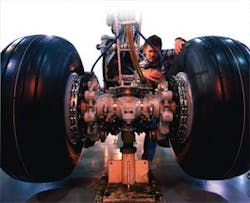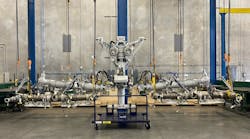Landing gear: At first glance, it appears to be the most rugged part of an aircraft. But landing gear’s apparent robustness masks its vulnerability to corrosion and stress damage due to impacts — a vulnerability that can result in a substantially reduced operational lifespan (well below manufacturers’ specs) and increased overhaul costs.
What can an aircraft technician do to keep landing gear in top condition between scheduled overhauls? According to Goodrich’s Landing Gear Division in Burlington, Ontario, quite a lot.
Understanding the life of landing gear
The life of an average aircraft’s landing gear is a hard one. At all times, its pressurized oleo-pneumatic shock-absorbers exert stress on their metal housings. Meanwhile, the force of hitting the runway upon landing stresses the entire system, no matter how gentle the landing. Horizontal forces are also exerted on the gear as the aircraft brakes during landing or accelerates during takeoff.
That’s not all. Towing strains the forward landing gear, especially if the tow is not executed gracefully. Add impacts and collisions with other objects on the tarmac, and landing gear can be bent, cracked, and even collapsed due to aircraft accidents.
In the hangar, “landing gear can be damaged by inappropriate jacking and other forms of mishandling,” says Jay Lind, Goodrich Landing Gear Quality Assurance manager. “Even pressure washing the gear to make it look spotless can cause problems, because it can force water into the bushings and joints, causing corrosion.”
If this isn’t enough to worry about, certain solvents such as paint stripper can cause ‘hydrogen embrittlement’ in gear. What happens is that atomic hydrogen found in such substances interacts chemically with the high tensile steel in the gear, causing the affected areas to transform chemically into a brittle alloy with a risk of fracturing. “The only way to counteract hydrogen embrittlement is to remove the affected component and bake it in a special oven at 375 F for 23 hours,” Lind tells AMT. “This allows the hydrogen atoms to migrate to the surface and then escape.”
Maintenance best practices
When damaged aircraft landing gear comes into the shop, it costs more to overhaul than landing gear that has been maintained properly. Here is what you can do to keep your landing gear costs down.
The first step is lubrication. It may sound simple, but insufficient lubrication during regular usage causes unnecessary wear-and-tear in many of the system’s components.
“Lubrication is critical to the movement of all articulated parts and joints of landing gear,” says Lind. “Proper lubrication ensures smooth functioning, less friction and wear, and the appropriate transfer of forces throughout the gear during use. Lubrication is key to keeping out water, de-icing fluid, and other corrosion-causing substances. Make no mistake; corrosion is a real problem for landing gear.”
Before you lubricate, be sure to check the aircraft’s manual to find out what substances you can and cannot use. “In some cases, using the wrong grease can be as detrimental as insufficient lubrication, because it can cause damage to the gear’s bushings,” says Lind.
Another best practice in maintaining landing gear is protecting it from paint strippers and other corrosive agents. This is due to the interaction between hydrogen and the high tensile steel used in the gear. If acids are allowed to contaminate the gear, the resulting hydrogen embrittlement can lead to cracks. At the least, such cracks are expensive to fix. At the most, the cracks may be sufficiently large that the component has to be scrapped and replaced — hopefully before the gear fails in use.
Avoiding impacts of any kind is one more best practice for landing gear maintenance. The pressurized shock-absorbing struts are particularly vulnerable to nicks, dings, and dents. “Any change in the shape of the struts, or indeed any other support structures of the gear, results in ’stress risers’ in the component,” says Lind. “This makes it more vulnerable to failure due to metal fatigue, potentially long before the next scheduled overhaul comes about.”
When things do go wrong — and things do — it is important to document the kind of accident suffered by the gear, and what visual damage can be seen. The smartest thing to do in such cases is to swap out the component immediately and send it off for nondestructive testing and repair, accompanied by the record of what happened to it. This allows landing gear MROs such as Goodrich to do the repair work accurately, before the damage becomes more serious and thus more expensive to fix.
Documentation of each serialized part of your gear is also vital for keeping overhaul costs down. “Like engines, serialized components in landing gear have specified operational lifespans, after which time they must be replaced,” says Lind. “In cases where we do not have such information, we have no choice but to scrap the undocumented part and replace it with something new. The same is true for parts with illegible serial numbers. Unless we can be sure of their history and lifespan, we have to scrap them.”
Operational conclusions
The landing gear best practices outlined by Lind can be distilled into a series of ‘operational conclusions’ or fancy words for things you should do as a matter of course to keep your gear at optimal condition.
First things first: For every piece of gear you service, go over the manuals. In particular, compile a list of ‘forbidden substances’ that should not be used around unprotected gear. Also double-check the regular maintenance/lubrication protocols, because these can differ from aircraft to aircraft.
Next, go over the documentation for the gear you service. Is there a complete history for each serialized component? If not, spot the holes and be prepared to replace the undocumented parts. After you’ve incurred this expense, keep complete records to avoid having to pay for it again.
Third, review your shop’s procedures to ensure that other unrelated work such as paint stripping and cleaning are not putting your gear at risk. Where required, either protect your gear from overspray or change your stripping/cleaning processes.
Fourth, ensure that there is a complete reporting procedure for each aircraft’s landing gear, both to alert you to accidents when they happen and to provide accurate historical information for the overhaul shop. This may require a slight change in corporate culture; i.e. to one where reporting a mishap doesn’t necessarily lead to disciplinary action. If your staff is scared to report accidents, they won’t ... and you will pay the price later during overhauls.
Finally, don’t be fooled by the apparent robustness of landing gear. Like every other critical system on an aircraft, landing gear has its own vulnerabilities that have to be monitored and cared for — at least if you want to keep overhaul costs down and flight safety up.


